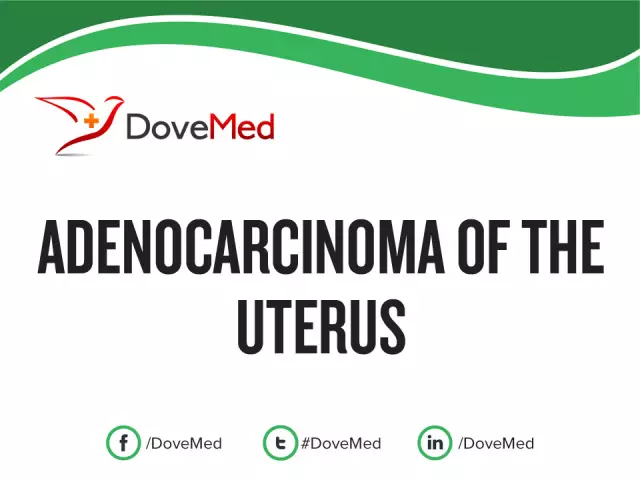- Author Rachel Wainwright [email protected].
- Public 2023-12-15 07:39.
- Last modified 2025-11-02 20:14.
Adenocarcinoma

Adenocarcinoma is an organ-nonspecific malignant formation formed by altered cells of the glandular epithelium lining the internal organs. Adenocarcinoma affects various organs, that is, this disease is not characterized by a clear localization.
Adenocarcinoma: Typology of Malignant Neoplasms
The term adenocarcinoma is also applied to a number of malignant neoplasms that, during development, affect the glands of the body. A feature of the cells that form adenocarcinoma is the ability to produce mucus. According to the type of secretion produced, adenocarcinomas are subdivided into serous and muco-secretory. The neoplasm can be homogeneous or form cavities, the so-called cysts. In this case, it is customary to talk about cystadenocarcinoma.
Adenocarcinomas can be of various sizes, their structure and shape completely depend on the structural and functional characteristics of the cells of the organ tissue that form the tumor.
There are two main stages in the morphological genesis of adenocarcinoma:
- Pretumor tissue changes;
- Stage of tumor formation and growth.
According to the degree of differentiation (acquisition of certain profile functions by cells), adenocarcinomas are divided into:
- Poorly differentiated - adenocarcinomas, the structure of which cannot be associated with a specific tissue, are characterized by the highest degree of malignancy, the ability to form metastases;
- Moderately differentiated - tumors, the structure of which is difficult to associate with the structure of the tissue, the cells of which it is formed;
- Highly differentiated - tumors characterized by a structure similar to the structure of the tissue, the cells of which form a malignant neoplasm.
Adenocarcinoma of the stomach
Adenocarcinoma of the stomach is a histological type of stomach cancer. According to the classification of the World Health Organization, the following types of gastric adenocarcinomas are distinguished:
- Papillary;
- Tubular;
- Mucinous.
Adenocarcinoma of the stomach ranks fourth in the world among diagnosed malignant tumors. This disease is characterized by very high mortality rates, which puts it in second place after lung cancer among cancer mortality rates. Most often, gastric adenocarcinoma occurs in men. Metastases are formed in 82-94% of cases.
The main factors contributing to the development of adenocarcinoma are called:
- Features of the diet and diet (deficiency of ascorbic acid, excessive use of salt, pickled, smoked, salty foods, fried foods, animal oils);
- Genetic factor;
- Bad habits (smoking, alcohol abuse);
- Infectious inflammatory processes (Helicobacter Pylori infection).
The main symptoms of gastric adenocarcinoma are:
- Loss of appetite, impaired digestive function;
- Aversion to meat;
- Asthenia;
- Significant weight loss;
- Feeling early satiety (satiety from a small amount of food);
- Stomach discomfort;
- Vomiting, bleeding, changes in feces, bloating, retention of stool (late stage symptoms);
- Pains of a different nature.
In the early stages of development, the disease is asymptomatic. Adenocarcinoma of the stomach should be differentiated from peptic ulcers, gastritis, benign formations, and other malignant tumors. The symptomatic complex of the early stages of adenocarcinoma differs little from the symptomatology of most gastric diseases.
The main treatment for gastric adenocarcinoma is surgical excision of the tumor, often combined with gastric resection. Chemotherapy and radiation exposure are used as ancillary techniques.
Adenocarcinoma of the uterus
Adenocarcinoma of the uterus is a malignant hormone-dependent formation that affects the inner layer of the uterus - the endometrium. This form of the disease is the main morphological variant of uterine cancer. The disease is most often diagnosed in patients aged 40 to 60 years.
The main risk factors for the development of uterine adenocarcinoma are:
- Diabetes;
- Obesity;
- The presence of adenocarcinoma or other cancers of the genital organs, breast cancer, ovarian cancer in a family history;
- Hypertonic disease;
- An imbalance in the hormonal background of the body with an increased level of estrogen;
- Infertility.
The main symptoms of uterine adenocarcinoma are:
- Preceding endometrial diseases (inflammatory processes, polyps, endometrial adenomatosis (an increase in the number of glands in the endometrium), atypical hyperplasia of the functional and / or basal layers of endometrial tissue);
- Chronic pain in the lumbar region of a aching pulling character, not caused by other factors;
- Prolonged menstrual bleeding of a painful nature;
- Uterine bleeding in the middle of the cycle;
- Uterine bleeding during the postmenopausal period;
- Atypical pain in the lower abdomen;
- Purulent vaginal discharge with an unpleasant odor;
- Succinic discharge during intercourse.
There are 4 stages of the development of the disease, depending on which the tactics of treatment are determined. Adenocarcinoma of the uterus does not involve conservative treatment. Hormone therapy, combined with radiation therapy, is used in cases where surgery is not possible due to the patient's condition. At the first stage of the disease, the uterus with appendages is removed. When diagnosing the second stage of adenocarcinoma of the uterus, nearby lymph nodes, which may presumably be affected by metastases, are also removed.
Rectal adenocarcinoma
Rectum adenocarcinoma is a rectum cancer that develops from cells of the glandular epithelium. Adenocarcinoma of rectum is considered an age-related disease, more often this malignant formation is diagnosed in patients after 50 years.
The main risk factors for the development of rectal adenocarcinoma:
- Inadequate diet (lack of fruits and vegetables in the diet, excess of animal fats);
- Bad habits (smoking, alcohol abuse);
- Family history of gastrointestinal cancers, genetic predisposition;
- Chronic inflammatory processes, rectum polyps;
- Human papillomavirus infection;
- Anal intercourse.

Rectal adenocarcinoma symptoms:
- Blood in feces, discharge of pus and mucus during bowel movements;
- Pain in the rectum, especially with a bowel movement, foreign body sensation;
- Constipation and diarrhea.
In the absence of proper treatment, rectum adenocarcinoma grows into nearby organs, as a result of which fistulas form between the rectum, bladder, perineum, gases and feces are excreted through the urethra. Adenocarcinoma of rectum involves surgical treatment by removal or resection of the rectum.
The information is generalized and provided for informational purposes only. At the first sign of illness, see your doctor. Self-medication is hazardous to health!






